Results show that shrimp mortality, growth rates and energy budget were unaffected by the inclusion of algae in the shrimp feed
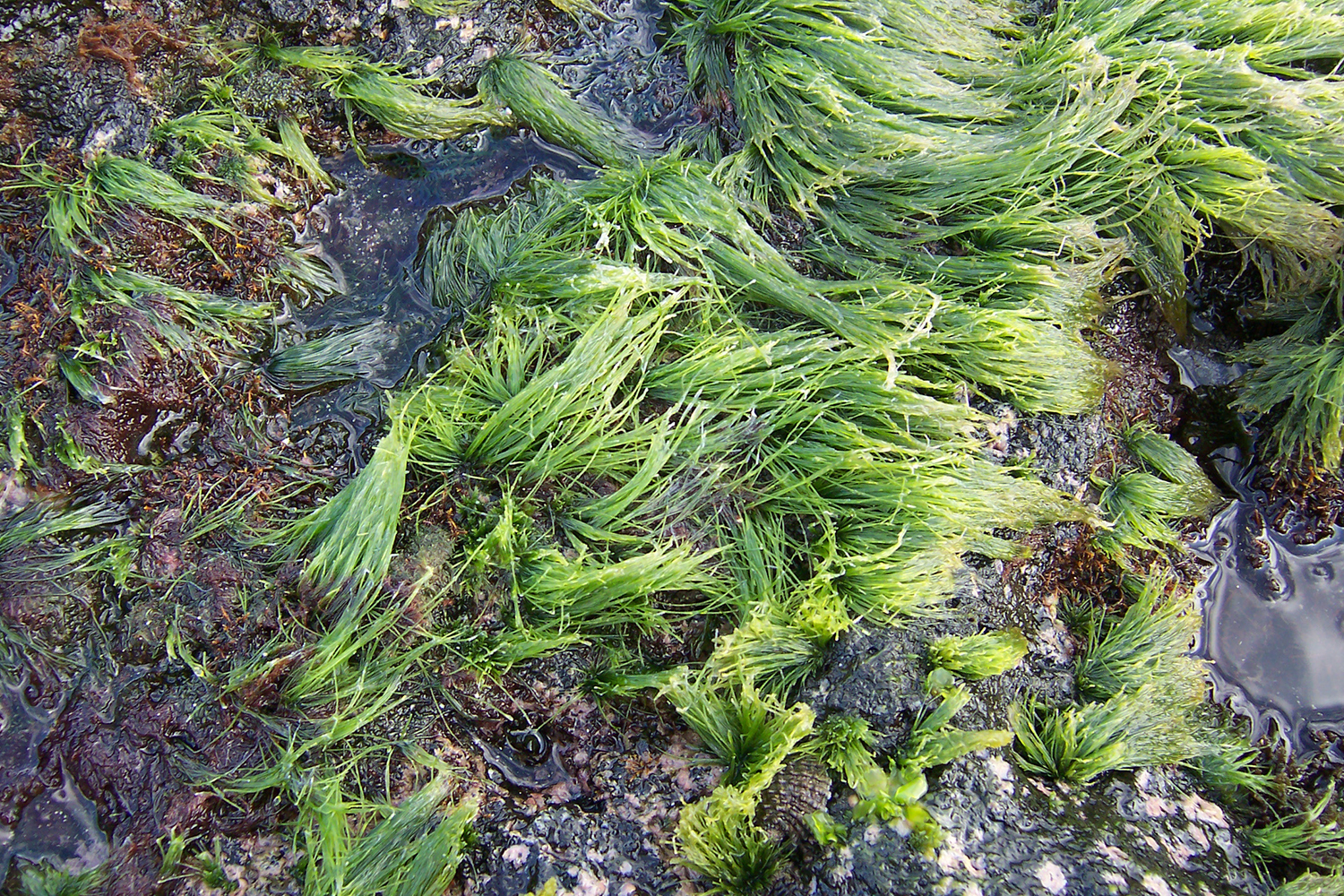
The use of dried marine macroalgae as a food supplement incorporated into commercial aquafeeds has been widely studied for some farmed species because they are an important source of nutrients such as amino acids, omega-3 and omega-6 fatty acids, as well as antioxidants and antimicrobials.
The genus Chaetomorpha comprises 77 species of marine and brackish water green algae, several of which grow in stagnant waters, including aquaculture ponds, aqueducts, and reservoirs. These algae can grow in salinities from freshwater to 90 ppt, have a wide tolerance to temperature variations from 20.1 to 40.9 degrees-C and high growth rates. Species of algae within this genus also exhibit a diversity of active antibacterial and antioxidant properties. Moreover, they act as biofilters, and as such have great potential for treating effluent water by removing nitrogen and phosphorus. Thus, the inherent characteristics of species within this genus could prove useful for aquaculture operations, and especially in IMTA systems.
One species, C. clavata, is particularly widespread geographically, occurring in North America (Florida and the Gulf of California), Central and South America (Brazil, Chile, Colombia and Venezuela), Africa and Asia. The use of this macroalga for feeding farmed shrimp like the Pacific white shrimp (Litopenaeus vannamei) has not yet been reported.
This article – summarized from the original publication [Pereira-Borges, E. et al. 2024. Physiological effects of feeding whiteleg shrimp (Penaeus vannamei) with the fresh macroalgae Chaetomorpha clavate.]. Aquaculture Reports, Volume 37, August 2024, 102222) – reports on a study to determine if P. vannamei would feed on C. clavata and assess shrimp mortality and growth, along with several additional physiological characteristics (ingestion, molting, metabolism, nitrogen excretion, oxidized energy substrate, hepatosomatic index, and energy budget), of shrimp fed a diet consisting of 50 percent of this macroalgae.
Study setup
Juvenile P. vannamei (4.36 grams ± 0.40) shrimp collected from shrimp farms in the state of Santa Catarina, Brazil, were transported to the Sustainable Aquaculture Laboratory, São Paulo State University (UNESP) in São Vicente, Brazil. After the acclimation period to the laboratory, the animals were weighed and divided into two groups, with 8 animals (N = 8) per treatment: treatment 1 (control) were animals fed only with commercial feed; and treatment 2 (feed + macroalgae) included animals fed 50 percent commercial feed and 50 percent fresh C. clavata macroalgae cultured in the Laboratory of Algae and Aquatic Plants, UNESP.
The shrimp were reared for 25 days in individual aquariums with aerated water with 25 ppt salinity, temperature of 25 degrees-C and 12-hour light:12-hour dark photoperiod. Ingestion and egestion, oxygen consumption and ammonia excretion were evaluated. Animals that at the end of the experiment were in the pre- or post-molt stage were excluded because such stages could cause changes in physiology, including body mass due to the high percentage of body hydration.
For detailed information on the experimental design, animal husbandry, data collection and analyses, refer to the original publication.
Potential marine resources to sustainably meet aquafeed ingredient demands
Results and discussion
Results showed that replacing 50 percent of the commercial feed with fresh algae had no effect on the growth or mortality rates of P. vannamei shrimp, nor did it lead to any notable changes in physiological parameters (metabolism, ammonia excretion, hepatosomatic index and energy budget). Based on these results, we propose that this substitution could be advantageous considering that it offers significant economic and environmental benefits because commercial feed is the most expensive production cost in aquaculture operations.
Ensuring proper animal nutrition is one of the most important factors in aquaculture because it affects the survival, growth, and health of the farmed species. We observed that the mortality rates of control animals and those given a diet of commercial aquafeed and algae were statistically similar, although there was a tendency for the latter to have a higher rate, possibly due to the number of replicates. In general, integrated cultivation of P. vannamei and algae can enhance shrimp survival and growth, while at the same time improving water quality. Although in our study we replaced 50 percent of the commercial feed with fresh macroalgae, future studies should assess whether a lower replacement level would be more suitable for P. vannamei culture, since other researchers have reported that higher percentages of feed replacement with algae can have a negative effect on survival.
Under natural conditions, P. vannamei shrimp is an omnivorous and opportunistic feeder with a diverse diet, indicating that it is capable of digesting most types of nutrients; indeed, analysis of wild P. vannamei stomach contents reveal that the animal feeds on a wide range of zooplankton, diatoms, filamentous algae and marine macroalgae. Moreover, crustaceans produced carbohydrate-degrading enzymes, further supporting the view that they rely on plants as a primary food source. We observed that P. vannamei ingestion rate increased following the substitution of 50 percent algae in their feed, a result similar to those found in other studies for this species provided feed supplemented with various green algae species.
This increase in ingestion rate could be attributed to several factors, including that green algae produce dimethyl sulfonyl propionate, a compound that can act as an attractant to some animals, consequently increasing consumption. Also, morphological characteristics such as the thickness, size, and shape of the algae thallus may play a role; for example, the thin thalli of C. clavata may have facilitated its consumption by P. vannamei.
Green macroalgae can promote crustacean growth due to the presence of certain proteins, free amino acids, and antioxidant complexes; however, no differences in growth rate were detected between animals fed a diet of full commercial feed and those fed a diet containing 50 percent fresh algae. Although our findings provide positive indications regarding the use of fresh C. clavata in the diet of P. vannamei, we suggest that substitutions of less than 50 percent should be assessed to determine whether lower levels promote even better growth results.
Although fundamental parameters for the cultivation of P. vannamei like survival, feeding, and growth were unaffected by the partial replacement of commercial feed with algae, other physiological data provide additional information on how energy is being used by the animals. Of these, oxygen consumption, nitrogen excretion, hepatosomatic index, and energy budget are good indicators of the energy flow needed for growth, survival and reproduction. Our results suggest that introducing fresh algae to the diet did not alter P. vannamei oxygen consumption and ammonia excretion; indeed, proteins were the main energy substrate oxidized regardless of the presence of algae in the diet.
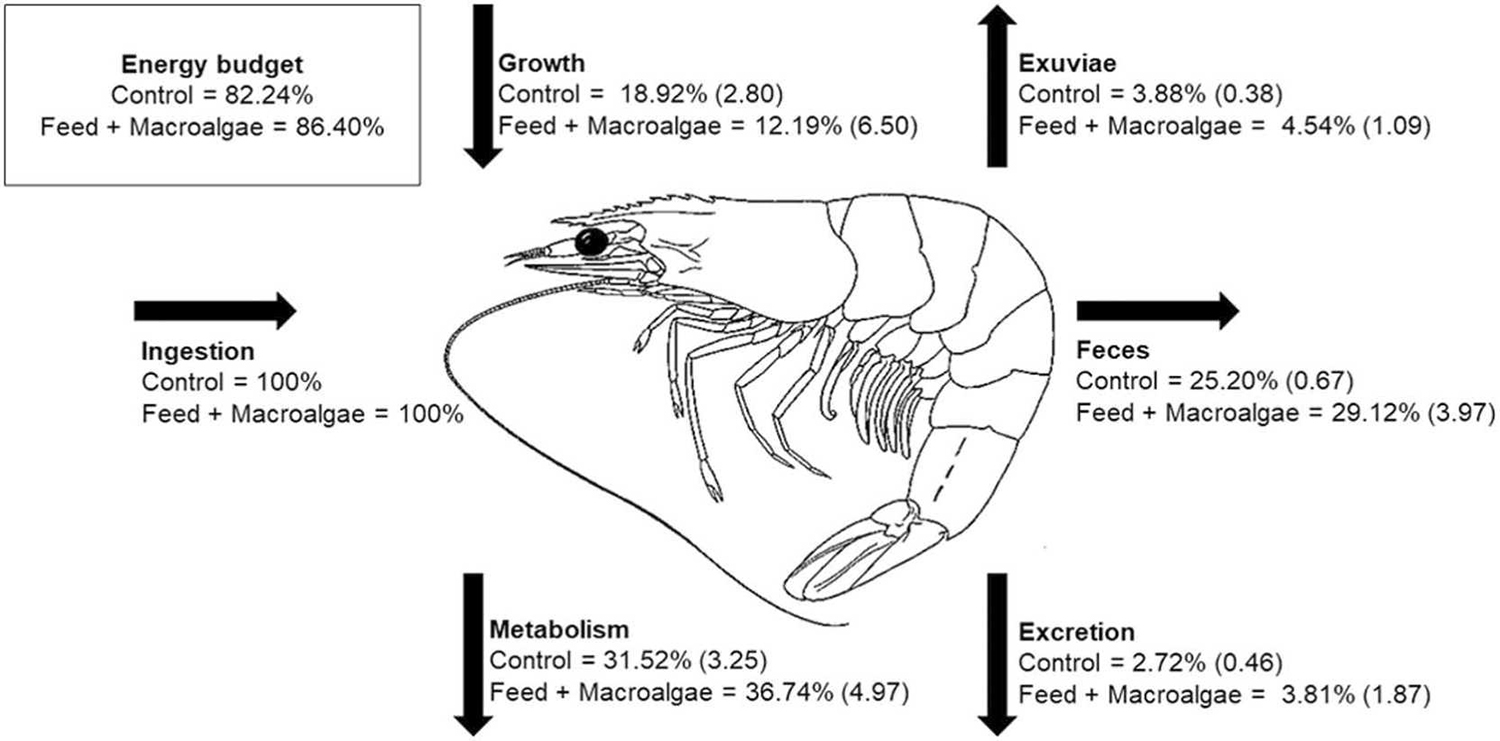
Assessment of hepatopancreatic function using the hepatosomatic index enables the identification of changes in the use of stored energy triggered by disruptions in homeostasis or consumption of unbalanced diets containing insufficient energy. We detected no changes in the hepatosomatic index of P. vannamei shrimp fed a 50 percent algae diet, suggesting that replacing half of the commercial feed with seaweed has no effect on the shrimp’s energy reserves. This is a crucial result because dietary changes should not lead to reductions in energy available for circumstances that increase energy demand, such as the introduction of abiotic stressors or reproduction.
Although diet is the main factor responsible for altering a species’ energy budget, the results of our analysis indicated that the partial replacement of feed with algae did not affect the energy budget of P. vannamei. In this species, 62 percent of all energy ingested is channeled into metabolism or feces (∼35 percent and ∼27 percent, respectively) and a small proportion (∼16 percent) is channeled into growth.
This seems to be a typical result for marine shrimp because other authors have shown that in shrimp such as P. vannamei and black tiger shrimp, P. monodon, the percentage of energy channeled into growth varies between 12 percent and 23 percent of the energy ingested. Although various studies may suggest that responses are species-specific, they also highlight the importance of using an appropriate diet for maintaining the proper energy budget for farmed species.
Perspectives
The present study is the first to demonstrate that P. vannamei shrimp feeds on the macroalgae C. clavata in the laboratory. Results show that substituting 50 percent of the feed with this macroalga represents a potential alternative to supplement commercial aquafeeds. In addition to the economic benefit of reducing the amount of feed used during culture, its use could also improve the quality of effluent water, thereby improving environmental sustainability and water quality.
Now that you've reached the end of the article ...
… please consider supporting GSA’s mission to advance responsible seafood practices through education, advocacy and third-party assurances. The Advocate aims to document the evolution of responsible seafood practices and share the expansive knowledge of our vast network of contributors.
By becoming a Global Seafood Alliance member, you’re ensuring that all of the pre-competitive work we do through member benefits, resources and events can continue. Individual membership costs just $50 a year.
Not a GSA member? Join us.
Author
-
Dr. Emanuelle Pereira-Borges
Corresponding author
Aquaculture Center of UNESP (CAUNESP), São Paulo State University (UNESP), Jaboticabal, SP 14884-900, Brazil[114,98,46,112,115,101,110,117,64,115,101,103,114,111,98,46,101,108,108,101,117,110,97,109,101]
Tagged With
Related Posts
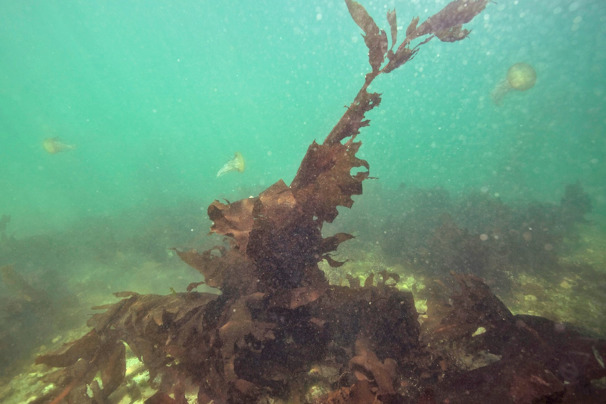
Aquafeeds
Assessing the effect of four macroalgae inclusions in diets of Pacific white shrimp
Evaluating macroalgae inclusions in L. vannamei diets show improved growth and intestinal microbiota and prevention of oxidative damage.
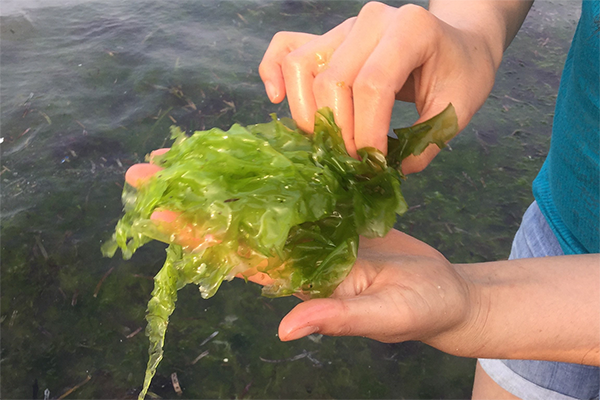
Intelligence
Effect of water depth on growth of the macroalgae Ulva lactuca in a biofloc system
Integrated biofloc culture of Pacific white shrimp, Nile tilapia and U. lactuca is feasible with shallow floats up to 10 cm in depth.
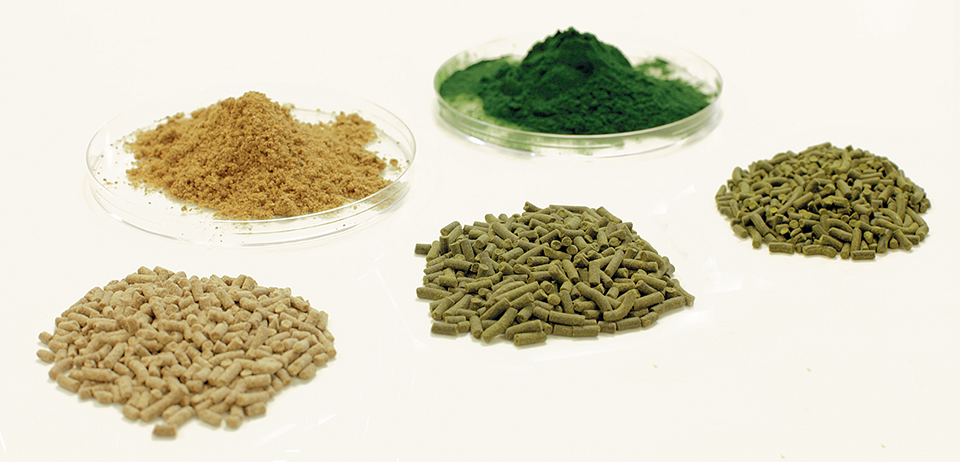
Aquafeeds
Algae alternative: Chlorella studied as protein source in tilapia feeds
Chlorella and other species have potential as protein sources in aquafeeds. In trials with tilapia fry raised in a recirculating system, the fish received a fishmeal-based control diet or feeds with portions of the fishmeal replaced by Chlorella.
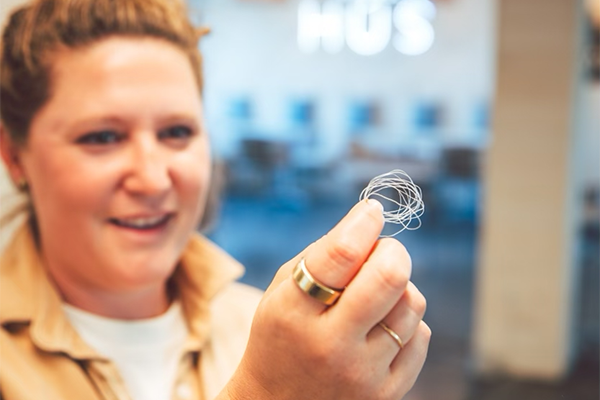
Innovation & Investment
‘Everyone is going to need a lot of seaweed’: Maine-based seaweed polymer innovator wants fisheries and aquaculture to quit plastics
Viable Gear Founder Katie Weiler joined the Advocate and Aquademia to discuss making lobster bait bags and other products with a seaweed polymer.



